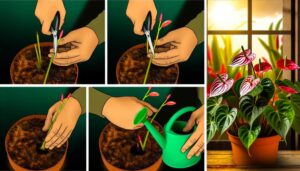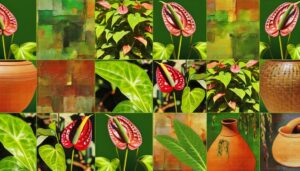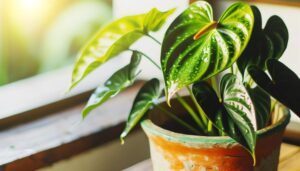10 Essential Steps for Anthurium Cobra Care
Caring for your Anthurium Cobra is straightforward with these 10 steps: Place it in bright, indirect sunlight and keep room temperature between 65-80°F. Use a well-draining soil mix with orchid bark, perlite, and peat moss.
Water when the top inch of soil is dry, ensuring thorough drainage. Maintain 60-80% humidity using a humidifier or pebble tray.
Prune dead or yellowing leaves with sterilized tools. Check regularly for pests like spider mites, applying insecticidal soap as needed.
Repot every 2-3 years, loosening roots gently. Monitor for nutrient deficiencies and keep soil moisture consistent.
For detailed care insights, continue exploring.

Key Takeaways
- Place Anthurium Cobra in bright, indirect sunlight near a north or east-facing window.
- Use a well-draining soil mix rich in organic matter, incorporating orchid bark, perlite, and peat moss.
- Water when the top inch of soil is dry and maintain humidity levels between 60-80%.
- Regularly inspect and prune dead or decaying leaves, making clean cuts at the base.
- Repot every 2-3 years using a slightly larger pot and fresh, well-draining potting mix.
Step 01: Choosing the Right Spot
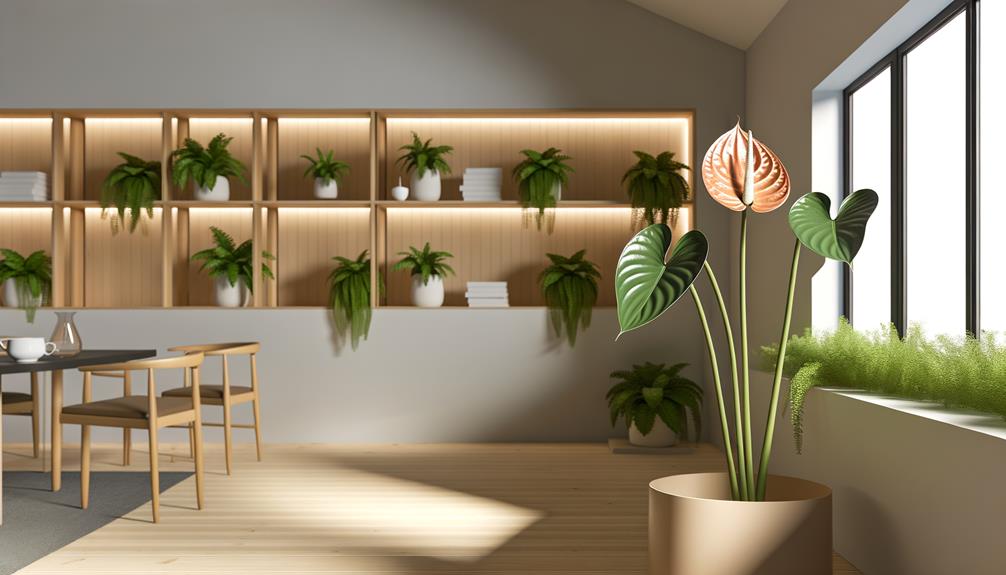
Selecting the perfect spot for your Anthurium Cobra involves guaranteeing it receives bright, indirect sunlight to thrive. Place it near a north or east-facing window where it can bask in filtered sunlight.
Avoid direct sunlight, as it can scorch the leaves. If natural light is insufficient, use grow lights to maintain a consistent light source.
Guarantee the room temperature stays between 65-80°F, avoiding cold drafts or sudden temperature changes. Keep humidity levels around 60-80%, using a humidifier if necessary. Rotate the plant periodically to promote even growth and prevent it from leaning towards the light source.
Step 02: Ideal Soil Mix
To maximize the health of your Anthurium Cobra, you’ll need a well-draining soil mix rich in organic matter. Incorporate components like orchid bark, perlite, and peat moss to achieve peak drainage and aeration.
This combination prevents root rot and promotes healthy growth by maintaining proper moisture levels and providing essential nutrients.
Soil Composition Essentials
For best growth, an Anthurium Cobra requires a well-draining soil mix rich in organic matter, such as a blend of orchid bark, perlite, and peat moss.
Start by mixing equal parts of orchid bark and perlite to ensure optimal drainage and root aeration. Add peat moss to improve moisture retention and provide essential nutrients.
This combination mimics the plant’s natural epiphytic habitat, offering a balance of moisture and air pockets. You might also incorporate a slow-release fertilizer to support ongoing nutrient availability.
Always moisten the mix before planting to activate the components and establish a suitable environment for root development. Remember, a balanced, organic-rich soil composition fosters strong growth and vibrant foliage in your Anthurium Cobra.
Drainage and Aeration
Promoting ideal drainage and aeration in the soil mix is crucial for preventing root rot and supporting healthy root systems for your Anthurium Cobra.
Begin by using a well-draining, airy substrate. A combination of orchid bark, perlite, and peat moss is recommended.
Mix these components in a ratio of 2:1:1. The orchid bark offers excellent drainage, the perlite boosts aeration, and the peat moss retains necessary moisture.
Make sure the pot has drainage holes to allow excess water to escape. You can also add a layer of charcoal at the bottom of the pot to enhance both drainage and aeration.
Regularly check the soil’s moisture level; it should be consistently moist but not waterlogged. This supports optimal root health and growth.
Step 03: Watering Guidelines
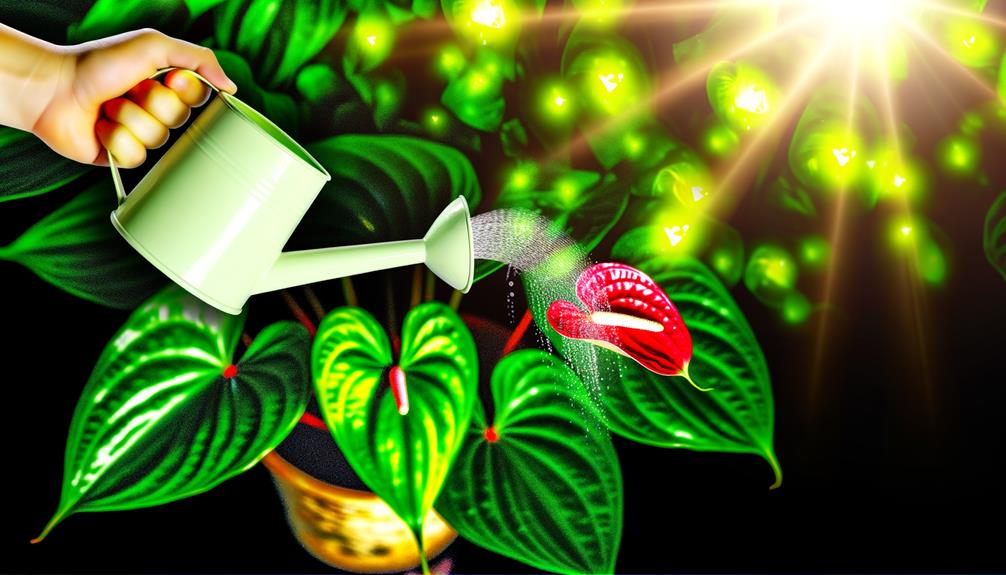
To sustain peak health for your Anthurium Cobra, water the plant when the top inch of soil feels dry to the touch.
Guarantee you provide adequate moisture without causing waterlogging, as this can lead to root rot.
Utilize a well-draining potting mix to help regulate appropriate moisture levels.
Optimal Watering Frequency
Water your Anthurium Cobra when the top inch of soil feels dry to the touch, ensuring the plant receives consistent moisture without becoming waterlogged.
Utilize a moisture meter for accuracy, aiming for a reading of 4-6. Avoid overwatering; saturated soil can lead to root rot. Employ a well-draining potting mix to facilitate proper water flow.
Water thoroughly until excess drains from the bottom, promoting deep root hydration. During active growth seasons, typically spring and summer, increase watering frequency.
In contrast, reduce watering during the dormant period in fall and winter. Always use room-temperature water to prevent shock.
Consistently monitor plant health, adjusting as needed to maintain the best hydration for your Anthurium Cobra’s flourishing growth.
Proper Moisture Levels
Maintaining proper moisture levels for your Anthurium Cobra involves consistently checking the soil’s dampness and striking a balance between hydration and drainage.
Follow these guidelines to optimize moisture:
- Soil Consistency: Guarantee the potting mix remains consistently moist but not waterlogged. Use a well-draining soil mix with organic matter to retain moisture without causing root rot.
- Watering Technique: Water thoroughly until excess water drains out the bottom. Empty the saucer to prevent stagnant water, which can lead to fungal issues.
- Humidity Maintenance: Sustain ambient humidity levels between 60-80%. Utilize a humidity tray or a room humidifier to achieve the desired moisture levels.
Step 04: Humidity Needs
Anthurium Cobra thrives in high humidity environments, requiring levels around 60-80% to maintain peak health.
To achieve these humidity levels, you can use a humidifier, mist the plant regularly, or place it on a pebble tray filled with water.
Ensure the water doesn’t touch the pot’s base to prevent root rot. Grouping plants can also elevate humidity levels. Monitor humidity with a hygrometer for accuracy.
| Method | Benefits | Considerations |
|---|---|---|
| Humidifier | Consistent humidity levels | Requires electricity |
| Misting | Quick and easy | Needs frequent application |
| Pebble Tray | Increases local humidity | Risk of root rot if water touches pot |
| Grouping Plants | Natural humidity boost | Limited by available space |
| Hygrometer | Accurate humidity readings | Initial investment required |
Step 05: Temperature Requirements
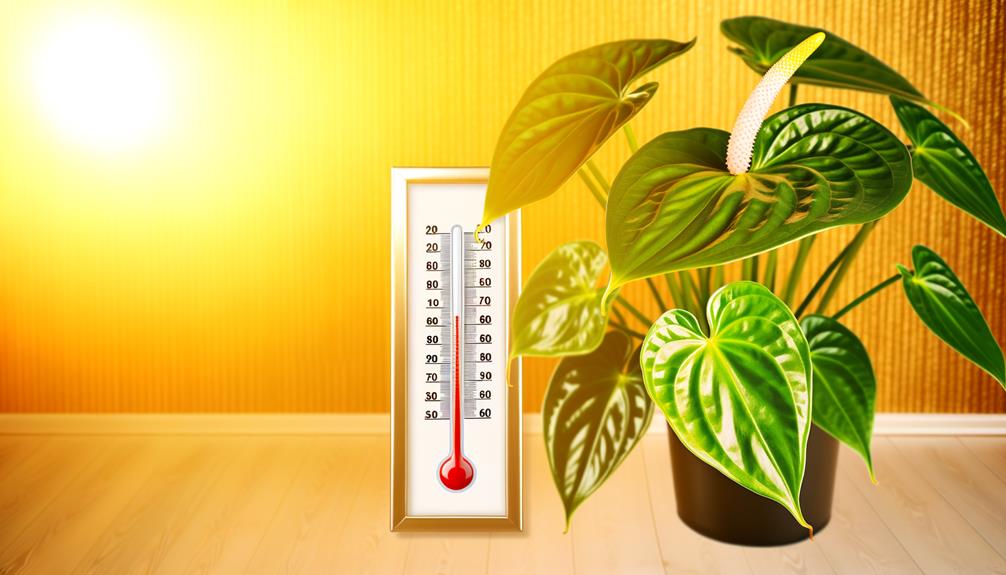
To maximize growth, keep the Anthurium Cobra in temperatures ranging between 65-80°F (18-27°C), avoiding sudden fluctuations. Maintaining consistent temperature is vital for its health.
Here’s how to guarantee ideal conditions:
- Monitor Room Temperature: Use a reliable thermometer to check the room’s temperature where your Anthurium Cobra resides. Consistency is key, so avoid placing it near heaters, air conditioners, or drafty windows.
- Seasonal Adjustments: During colder months, ensure the plant isn’t exposed to temperatures below 60°F (15°C). You might need to move it to a warmer spot.
- Heat Sources: If necessary, employ a gentle heat source, like a heat mat, to maintain a stable environment.
Step 06: Fertilizing Tips
For best growth, you’ll want to fertilize your Anthurium Cobra with a balanced, water-soluble fertilizer diluted to half-strength every 4-6 weeks during the growing season.
Make sure the fertilizer contains equal parts nitrogen, phosphorus, and potassium (N-P-K ratio of 10-10-10 or 20-20-20). Apply the diluted solution directly to the soil, avoiding contact with foliage to prevent leaf burn.
To enhance nutrient uptake, water the plant thoroughly before fertilizing. Monitor the plant for signs of over-fertilization, such as yellowing leaves or salt buildup on the soil surface.
During the dormant winter months, reduce fertilization frequency to every 8-10 weeks, as the plant’s nutrient requirements decrease.
Consistent, mindful fertilizing will support robust foliage and vibrant blooms.
Step 07: Pruning Techniques
When pruning your Anthurium Cobra, start by carefully removing any dead or yellowing leaves to maintain plant health and aesthetics.
Use sterilized pruning shears to make clean cuts close to the base of the stem. This process not only tidies up the plant but also encourages new growth and improved air circulation.
Removing Dead Leaves
Regularly removing dead leaves from your Anthurium Cobra helps prevent disease and encourages healthier growth. Dead foliage can harbor pathogens and pests, making it crucial to prune effectively.
Here’s how:
- Inspect Weekly: Check your plant for any yellowing or brown leaves. This frequent inspection ensures you catch and remove decaying leaves before they impact robust growth.
- Sterilize Tools: Use sterilized pruning shears to prevent transmitting diseases between cuts. Clean your tools with rubbing alcohol before and after each use.
- Cut at the Base: Make clean cuts at the base of the dead leaf’s petiole, close to the main stem. This method minimizes damage and promotes a tidy appearance.
These steps help maintain your Anthurium Cobra’s health and essentiality.
Encouraging New Growth
Pruning your Anthurium Cobra strategically can stimulate new growth by redirecting the plant’s energy towards developing fresh, healthy shoots. Start by sterilizing your pruning shears to prevent disease transmission.
Identify older leaves that are yellowing or damaged; cut these at the base, close to the main stem. Focus on removing any crowded or overlapping foliage to increase airflow and light penetration.
Make clean cuts at a 45-degree angle to avoid water pooling, which can lead to rot. Regularly inspect for any signs of pests or disease, as early intervention supports vigorous growth.
Step 08: Pest Control
Proper pest control for Anthurium Cobra involves identifying common pests such as spider mites, aphids, and mealybugs, and applying appropriate treatments promptly.
Begin by inspecting the plant’s leaves and stems regularly for signs of infestation. If you detect any pests, take immediate action to prevent further damage.
Here’s a concise plan:
- Prune Affected Areas: Remove and dispose of any heavily infested leaves or stems to reduce the pest population.
- Apply Insecticidal Soap: Spray a diluted insecticidal soap solution on all plant surfaces, ensuring thorough coverage. Repeat every 7-10 days until pests are eradicated.
- Introduce Beneficial Insects: Employ natural predators like ladybugs or lacewings to control pest populations without chemical intervention.
These steps will help maintain a healthy Anthurium Cobra.
Step 09: Repotting Advice
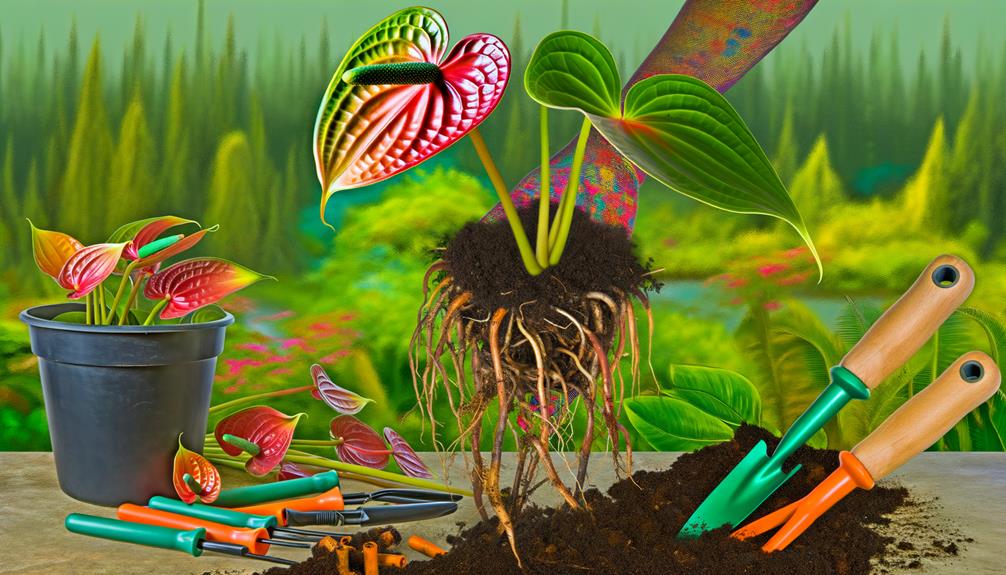
Repotting your Anthurium Cobra every 2-3 years guarantees ideal growth and prevents root bound conditions.
Start by selecting a pot that’s 1-2 inches larger in diameter than the current one. Prepare a well-draining potting mix, ideally a blend of orchid bark, peat, and perlite.
Gently remove the plant from its pot, carefully loosening the roots. Place the Anthurium in the new pot, filling it with the prepared potting mix, ensuring the roots are well-covered but not compacted. Water thoroughly to settle the soil.
| Task | Description |
|---|---|
| Select New Pot | Choose one 1-2 inches larger in diameter |
| Prepare Potting Mix | Use a blend of orchid bark, peat, and perlite |
| Remove and Loosen Roots | Gently take out the plant, loosen roots carefully |
| Replant and Water | Place in new pot, fill with mix, water thoroughly |
This process supports your plant’s health and encourages robust growth.
Step 10: Monitoring Plant Health
Regularly examine your Anthurium Cobra for signs of pests, diseases, and nutrient deficiencies to optimize plant health.
Check the undersides of leaves for aphids and mealybugs, which can lead to deformities and stunted growth.
Look for yellowing leaves, as this may suggest chlorosis due to a deficiency of essential nutrients like iron or magnesium.
To effectively monitor your plant, follow these steps:
- Visual Inspection: Inspect leaves and stems weekly for unusual spots, discoloration, or wilting.
- Soil Testing: Utilize a pH meter to examine soil acidity; Anthurium Cobras thrive in slightly acidic soil (pH 5.5-6.5).
- Moisture Levels: Maintain soil consistently moist but not waterlogged to prevent root rot.
Your vigilance will guarantee a thriving, healthy Anthurium Cobra.
Conclusion
To wrap up, mastering Anthurium cobra care is a delicate mix of accuracy and instinct. While the correct location guarantees sufficient light, an inappropriate soil blend can hinder growth.
Watering is vital, yet excessive amounts can lead to root rot. Elevated humidity mirrors their native environment but chilly temperatures can startle the plant. Trim to boost health, but be cautious of pests.
Repot considerately to foster growth. Keep a close watch, and you’ll see your Anthurium flourishing, a proof of your careful attention.


